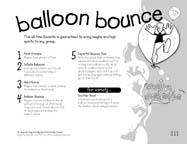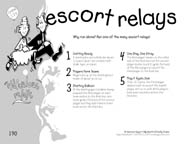Kagan's Articles - FREE Kagan Articles
Dr. Spencer Kagan
Silly Sports and Goofy Games - The Tenth Reason to Play: Brain-Friendly Instruction
To cite this article: Kagan, S. Silly Sports and Goofy Games – The Tenth Reason to Play: Brain-Friendly Instruction. San Clemente, CA: Kagan Publishing. Kagan Online Magazine, Winter 2004. www.KaganOnline.com
 For a quarter of a century, I collected Silly Sports and Goofy Games: Simple, brief classroom games and energizers. I was not interested in games that required complex rules or special equipment — my goal was to share with teachers things they could do "drop of the hat," with no special preparation, to increase the energy level in their classrooms, to have students cooperate, to provide challenges, and more than anything else, to simply make classrooms fun. I knew that when students had fun in class, the class tone shifted in a positive direction and the positive tone transferred to academics. Where there was no fun, there was less learning. By 1999, my collection of Silly Sports and Goofy Games had exceeded 200, and I asked our gifted artist, Celso Rodriguez, to help me present the games in a book. With many helpful suggestions from Laurie Kagan and Miguel Kagan, the book was completed and published in 2000. The result was a surprise. The book, Silly Sports and Goofy Games, quickly became one of Kagan Publishing's very most popular offerings. Teachers at all grade levels are using it to bring fun, cooperation, and challenges into their classrooms. Teachers report a more positive class climate and that this greater liking for class translates into increased academic success.
For a quarter of a century, I collected Silly Sports and Goofy Games: Simple, brief classroom games and energizers. I was not interested in games that required complex rules or special equipment — my goal was to share with teachers things they could do "drop of the hat," with no special preparation, to increase the energy level in their classrooms, to have students cooperate, to provide challenges, and more than anything else, to simply make classrooms fun. I knew that when students had fun in class, the class tone shifted in a positive direction and the positive tone transferred to academics. Where there was no fun, there was less learning. By 1999, my collection of Silly Sports and Goofy Games had exceeded 200, and I asked our gifted artist, Celso Rodriguez, to help me present the games in a book. With many helpful suggestions from Laurie Kagan and Miguel Kagan, the book was completed and published in 2000. The result was a surprise. The book, Silly Sports and Goofy Games, quickly became one of Kagan Publishing's very most popular offerings. Teachers at all grade levels are using it to bring fun, cooperation, and challenges into their classrooms. Teachers report a more positive class climate and that this greater liking for class translates into increased academic success. 
About a year ago, Dook Kopmels asked if his team at the Regional Pedagogisch Centrum Zeeland could translate the book into Dutch. Dook and his co-workers in the Netherlands had translated our Multiple Intelligences book into Dutch and the book has had a very positive reception. I was honored to have Silly Sports and Goofy Games available for Dutch speaking educators, but something was bothering me: When I looked at Silly Sports and Goofy Games by the end of 2003, it was with new eyes. In the four years since writing Silly Sports, I have been intensely involved in brain research. Applying brain-science to inform classroom practices has become a passion for me. In looking over the Silly Sports book, which I had written only a few years ago, I was shocked to realize I had never addressed the topic of why the games are tools to align classroom practice with how the brain best learns.
The introductory chapter, Why Play?, contains nine reasons to use the games — but it left out brain science.
|
The Original Nine Reasons to Play: |
|
Thus, I told Dook the Dutch translation had to include the tenth reason to play: Brain-Friendly Instruction.
If you have been using the games, you know how powerful they are. You don't need me to tell you they are brain-friendly; you see it in your students. If you are new to Silly Sports and Goofy Games, perhaps posting this tenth reason will motivate you to begin including play in your classroom.
The Tenth Reason to Play: Brain-Friendly Instruction
Brain science reveals that Silly Sports and Goofy Games are not so silly or goofy after all. Based on technological advances, the findings of brain science have been multiplying at an exponential rate: We have learned more about the brain in the last five years than in all prior history. Educators are discovering how to apply the findings of brain science to align classroom practices with how the brain best learns. It turns out Silly Sports and Goofy Games help us greatly in making a brain-friendly classroom.
 The brain is a busy place. The brain has about 100 billion neurons, each of which has about 2,000 synapses. Each of those synapses fires about 200 times a second. To support all that activity the brain needs a great deal of nourishment. Although the brain is only 2% of the body's weight, it consumes about 20% of the oxygen and glucose produced by the body. It takes a great deal of fuel to keep all those neurons functioning optimally. If we cut off the supply of oxygen to the brain, brain cells begin dying within five minutes. If we reduce the supply of oxygen to the brain, brain cells lose their ability to function optimally. That is one reason Silly Sports and Goofy Games are so important: Silly Sports and Goofy Games actually provide nourishment to the brain. As students play, even if it is only for a two or three-minute game of quick tag, their heart rate and volume increases, pumping more oxygen and glucose to the brain. Their respiratory rate and volume increase as well, oxygenating the blood. With more oxygen and glucose pumped to the brain, students are more alert. Thus, Silly Sports and Goofy Games actually nourish the brain, aligning our classroom practices with how the brain best learns. The increased nourishment is not just a temporary effect. Recent research has shown long-term effects of exercise: Students who engage in regular exercise actually grow an improved circulatory system in the brain; this increased circulatory capacity actually nourishes their brains better on an ongoing basis.
The brain is a busy place. The brain has about 100 billion neurons, each of which has about 2,000 synapses. Each of those synapses fires about 200 times a second. To support all that activity the brain needs a great deal of nourishment. Although the brain is only 2% of the body's weight, it consumes about 20% of the oxygen and glucose produced by the body. It takes a great deal of fuel to keep all those neurons functioning optimally. If we cut off the supply of oxygen to the brain, brain cells begin dying within five minutes. If we reduce the supply of oxygen to the brain, brain cells lose their ability to function optimally. That is one reason Silly Sports and Goofy Games are so important: Silly Sports and Goofy Games actually provide nourishment to the brain. As students play, even if it is only for a two or three-minute game of quick tag, their heart rate and volume increases, pumping more oxygen and glucose to the brain. Their respiratory rate and volume increase as well, oxygenating the blood. With more oxygen and glucose pumped to the brain, students are more alert. Thus, Silly Sports and Goofy Games actually nourish the brain, aligning our classroom practices with how the brain best learns. The increased nourishment is not just a temporary effect. Recent research has shown long-term effects of exercise: Students who engage in regular exercise actually grow an improved circulatory system in the brain; this increased circulatory capacity actually nourishes their brains better on an ongoing basis.
A classroom is lagging. It is after lunch or during a lengthy presentation. The teacher has students get up and do a brief tag or challenge game. Students return to their seats more alert and refreshed, ready to process new information. Teachers who do frequent brain breaks not only have a more interesting, fun class — their class achieves at a higher level academically. Silly Sports and Goofy Games refresh and nourish the brains of students so they are more capable and alert.
 Nourishing the brain is just one way Silly Sports and Goofy Games create a brain-friendly classroom. Our brains constantly scan the environment, seeking and attending to novel stimuli. In terms of evolution, this makes sense: Those animals that do not become more alert when faced with novel stimuli do not respond well to challenges and opportunities, and so are less likely to pass along their genes. Imagine students working for some length of time on a series of problems. They become bored. What is boredom? It is a lack of novel stimuli. Their brains begin to function at lower levels. Suddenly the teacher says, "Let's have a brain break!" calling for students to do Mirror Mirror or any of the other 200 Silly Sports or Goofy Games. Students stand up. Quickly they become intensely engaged. Why? They are attending to novel stimuli. After a few minutes, the students return to their seats, refreshed. Their increased alertness caused by the novel stimuli transfers to academic work, and achievement is increased.
Nourishing the brain is just one way Silly Sports and Goofy Games create a brain-friendly classroom. Our brains constantly scan the environment, seeking and attending to novel stimuli. In terms of evolution, this makes sense: Those animals that do not become more alert when faced with novel stimuli do not respond well to challenges and opportunities, and so are less likely to pass along their genes. Imagine students working for some length of time on a series of problems. They become bored. What is boredom? It is a lack of novel stimuli. Their brains begin to function at lower levels. Suddenly the teacher says, "Let's have a brain break!" calling for students to do Mirror Mirror or any of the other 200 Silly Sports or Goofy Games. Students stand up. Quickly they become intensely engaged. Why? They are attending to novel stimuli. After a few minutes, the students return to their seats, refreshed. Their increased alertness caused by the novel stimuli transfers to academic work, and achievement is increased.
Silly Sports and Goofy Games also help align the classroom environment with the state of relaxed alertness optimal for brain functioning. If students are too relaxed or drowsy, they do not learn well. If they are too aroused or anxious, they do not learn well. Good classroom management includes monitoring student energy levels. The goal of monitoring energy levels is to move the class into the optimal state of relaxed alertness. If the class is lagging, it is the job of the teacher to energize the class; if the class is too excited, it is the job of the teacher to provide a calming activity; if the class is too distracted, the good teacher provides focus. Silly Sports and Goofy Games can help in all these goals, helping students maintain a state in which they are relaxed but alert. Some Silly Sports and Goofy Games are energizers (eg., Everyone's IT!; Moon Jump; Home Run Relay, etc.), picking up the class when energy levels sag. Other Silly Sports and Goofy Games are calming (Willow-in-the-Wind; Care Lift; Move & Be). Yet other games create focus (Magic 11; Ten Count; Show Me — Don't Show Me). All of the Silly Sports and Goofy games create a safe environment — there are no winners or losers. Students experience excitement in a safe context with the absence of threat. Thus, Silly Sports help the teacher manage energy and attention, moving the class to the state of relaxed alertness optimal for learning.
 There are three other ways in which Silly Sports and Goofy Games create a brain-friendly classroom: emotion, challenges, and social interaction. The brain remembers events associated with emotion. When there is emotion, the neurons in the brain actually fire at an increased level signaling the hippocampus that "this stimuli is worth remembering." This makes sense also in terms of evolution. Anything that creates fear, pleasure or any of the other emotions has survival implications; remembering emotionally-laden events gives us an advantage. Many of the Silly Sports and Goofy Games elicit emotion. When that heightened emotional state transfers to classroom activities, academic activities are better remembered. The brain is a problem-solving organ, becoming alert and attentive in the face of challenges. Thus, the challenge games help tune the brain. Finally, the brain is a social organ. Active brain imaging studies reveal the brain is more engaged in response to social stimuli than any other. And, of course, all of the Silly Sports and Goofy Games involve social interaction. This, in part, explains why students enjoy the games so much — Silly Sports and Goofy Games allow students to attend to the type of stimuli their brains most crave.
There are three other ways in which Silly Sports and Goofy Games create a brain-friendly classroom: emotion, challenges, and social interaction. The brain remembers events associated with emotion. When there is emotion, the neurons in the brain actually fire at an increased level signaling the hippocampus that "this stimuli is worth remembering." This makes sense also in terms of evolution. Anything that creates fear, pleasure or any of the other emotions has survival implications; remembering emotionally-laden events gives us an advantage. Many of the Silly Sports and Goofy Games elicit emotion. When that heightened emotional state transfers to classroom activities, academic activities are better remembered. The brain is a problem-solving organ, becoming alert and attentive in the face of challenges. Thus, the challenge games help tune the brain. Finally, the brain is a social organ. Active brain imaging studies reveal the brain is more engaged in response to social stimuli than any other. And, of course, all of the Silly Sports and Goofy Games involve social interaction. This, in part, explains why students enjoy the games so much — Silly Sports and Goofy Games allow students to attend to the type of stimuli their brains most crave.
We have known for years that students love the Silly Sports and Goofy Games and that these simple activities transform the tone of the classroom and boost achievement. It is only now, with advances in brain science, that we understand why these simple activities have such a profound positive impact. Silly and goofy? From a student's perspective, yes. From the perspective of brain science, not at all!









